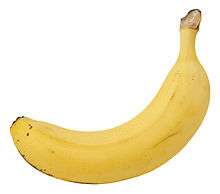Gros Michel banana
Gros Michel, often known as "Big Mike", is an export cultivar of banana and was, until the 1950s, the main variety grown.[2] The physical properties of the Gros Michel make it an excellent export produce; its thick peel makes it resilient to bruising during transport and the dense bunches that it grows in make it easy to ship.[3]
| Gros Michel | |
|---|---|
 Gros Michel bananas in various stages of ripening on a counter | |
| Species | Musa acuminata |
| Cultivar group | AAA Group |
| Cultivar | Gros Michel |
| Origin | Martinique, Jamaica[1] |
Taxonomy
Gros Michel is a triploid cultivar of the wild banana Musa acuminata, belonging to the AAA group.[4]
Its official designation is Musa acuminata (AAA Group) 'Gros Michel'.
Synonyms include:
- Musa acuminata L. cv. 'Gros Michel'
- Musa × paradisiaca L. cv. 'Gros Michel'
Gros Michel is known as Guineo Gigante, Banano, and Plátano Roatán in Spanish. It is also known as Pisang Ambon in Malaysia and Indonesia, Thihmwe in Burma, Chek Ambuong in Cambodia and Kluai hom thong in Thailand.[4]
Cultivation history
Early popularity and decline
_(20166670479).jpg)
French naturalist Nicolas Baudin carried a few corms of this banana from Southeast Asia, depositing them at a botanical garden on the Caribbean island of Martinique. In 1835, French botanist Jean François Pouyat carried Baudin's fruit from Martinique to Jamaica.[5] Gros Michel bananas were grown on massive plantations in Honduras, Costa Rica, and elsewhere in Central America.
This variety was once the dominant export banana to Europe and North America, grown in Central America, but in the 1950s, Panama disease, a wilt caused by the fungus Fusarium oxysporum f.sp. cubense, wiped out vast tracts of Gros Michel plantations in Central America, though it is still grown on non-infected land throughout the region.[6]
By the 1960s, the exporters of Gros Michel bananas were unable to keep trading such a susceptible cultivar, and started growing resistant cultivars belonging to the Cavendish subgroup (another Musa acuminata AAA).[6]
Genetic modification
There are efforts to use genetic modification to create a version of the Gros Michel which is resistant to Panama disease.[7] There have also been successful hybrids of Cavendish and Gros Michel that display a resistance to Panama disease.
A 2013 paper described experiments to create a version of Gros Michel which is resistant to black sigatoka.[8]
Cultural references
"Yes! We Have No Bananas", a novelty song about a grocer from the 1922 Broadway revue Make It Snappy, is said to have been inspired by a shortage of Gros Michel bananas, which began with the infestation of Panama disease early in the 20th century.[9]
See also
- Banana cultivar groups
- Grand Nain (Chiquita banana)
- Banana breeding impeded by triploidy
- Cooking plantain
References
- Robert J. Lancashire (25 August 2006). "Jamaican bananas and plantains". The Department of Chemistry, University of the West Indies. Archived from the original on 22 July 2011. Retrieved 11 January 2011.
- Koeppel, Dan (2008-06-18). "Yes, We Will Have No Bananas" (Editorial). New York Times. Retrieved 2008-06-18.
- "The History of Banana Flavoring". Lucky Peach. 2016-05-19. Archived from the original on 2017-06-27. Retrieved 2017-04-11.
- Michel H. Porcher; Prof. Snow Barlow (2002-07-19). "Sorting Musa names". The University of Melbourne. Retrieved 11 January 2011.
- Dan Koeppel (2008). Banana: the fate of the fruit that changed the world. Hudson Street Press. pp. 33. ISBN 978-1-4295-9325-0.
- "Panama Disease: An Old Nemesis Rears Its Ugly Head Part 1: The Beginnings of the Banana Export Trades". apsnet.org. Archived from the original on 2018-08-21. Retrieved 2016-03-15.
- Dale, James; James, Anthony; Paul, Jean-Yves; Khanna, Harjeet; Smith, Mark; Peraza-Echeverria, Santy; Garcia-Bastidas, Fernando; Kema, Gert; Waterhouse, Peter (2017-11-14). "Transgenic Cavendish bananas with resistance to Fusarium wilt tropical race 4". Nature Communications. 8 (1): 1496. doi:10.1038/s41467-017-01670-6. ISSN 2041-1723. PMC 5684404. PMID 29133817.
- Kovács, Gabriella; Sági, László; Jacon, Géraldine; Arinaitwe, Geofrey; Busogoro, Jean-Pierre; Thiry, Els; Strosse, Hannelore; Swennen, Rony; Remy, Serge (2013). "Expression of a rice chitinase gene in transgenic banana ('Gros Michel', AAA genome group) confers resistance to black leaf streak disease". Transgenic Research. 22 (1): 117–130. doi:10.1007/s11248-012-9631-1. PMC 3525978. PMID 22791138.
- Koeppel, Dan (19 June 2005). "Can This Fruit Be Saved?". Popsci.com. Archived from the original on 21 February 2014. Retrieved 2008-06-22.
